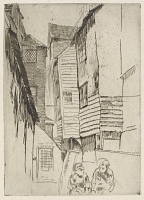Etchings Institutions search term: grolier club
Little Smithfield | ||
| Number: | 154 | |
| Date: | 1875 | |
| Medium: | etching | |
| Size: | 136 x 99 mm | |
| Signed: | no | |
| Inscribed: | no | |
| Set/Publication: | no | |
| No. of States: | 1 | |
| Known impressions: | 7 | |
| Catalogues: | K.160; M.157; W.78 | |
| Impressions taken from this plate (7) | ||
KEYWORD
TITLE
'Little Smithfield' (1870s, Whistler). 1
'Smithfield No. 1' (1877, Whistler). 2
'Little Smithfield' (1886, Frederick Wedmore (1844-1921)). 3
'Smithfield' (1887/1888, Whistler). 4
However, the original title, 'Little Smithfield' has been generally accepted by later cataloguers.
2: Whistler to C. A. Howell, 14-16 November [1877], GUW #13668.
3: Wedmore 1886 A (cat. no. 78).
4: List, [1887/1888], GUW #13233.
DESCRIPTION
SITE
5: 'Archaeology and photography', The Times, London, 6 July 1877, p. 4.
6: George Clinch, 'Glimpses of Mediaeval London', in Memorials of the Counties of England, General Editor: Rev. P. H. Ditchfield, Vol. 1, 'Memorials of Old London', p. 116, at www.gutenberg.org (accessed 2009).
DISCUSSION
8: Wedmore, op. cit.


